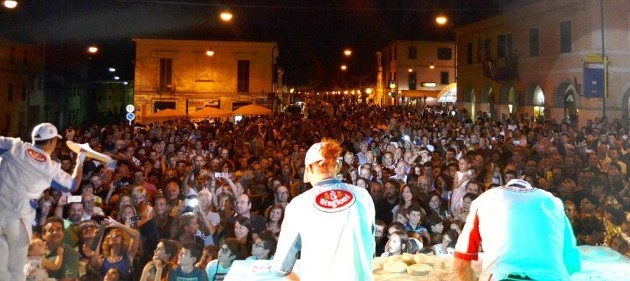San Lorenzo in Campo is a quiet village of Le Marche region and it's located in the Cesano Valley, in the province of Pesaro and Urbino.It is at short distance to the Adriatic Coast and the Apennines of Umbria-Le Marche. It includes two hamlets: Monfalcone and San Vito, two characteristic villages nestled in the countryside.
Things to visit in San Lorenzo in Campo
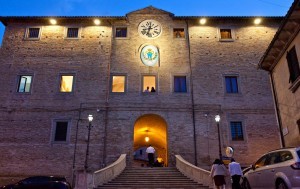
The historic center still keeps its original plan, with small streets, entrance arches and ancient walls. In the highest part of the town was standing a fortress but today you can just find some remains. In the charming square Piazzetta Padella you will find the palace Palazzo della Rovere, today housing the Archaeological Museum of Suasa and the town theatre Mario Tiberini; the sixteenth century palace Palazzo Amatori and that one of the Roman princes Ruspoli. Not far from the center rises the Benedictine Abbey, one of the most beautiful Romanesque-Gothic monuments of Le Marche region. Of great interest the churches Chiesa della Pieve, Chiesa del SS. Crocifisso and many other smaller but charming religious buildings.
The Archaeological Museum of Suasa
It is located inside Palazzo della Rovere and is divided into two parts referring to past history thought the geological evolution, fossils and remainings from the Roman age up to the Middle Ages. Inside there is also a media room and a classroom with organized courses for both adults and children.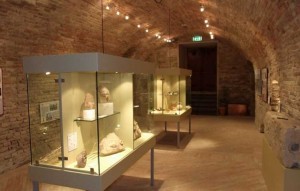
The Benedectine Abbey
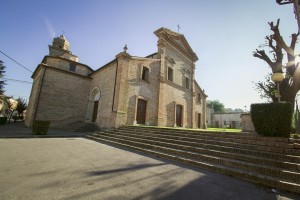 It was built between the VII and IX centuries on the ruins of the temple of Adonis and was expanded by the monks. It is an impressive building, with three naves and brick rounded arches supported by columns made of gray granite coming from the Eastern Countries. The central part of the Abbey is the oldest one and is made of marble and other fine materials, including the main altar. There is also a beautiful crypt rediscovered in 1940. Inside, the Abbey preserves many paintings such as the canvas of Ramazzani di Arcevia depicting the Madonna and Saints, the Table by Agapiti, depicting St. Demetrius and St. Lawrence and the great canvas of Terenzio Terenzi called the Rondolino, which depicts Our Lady with the Child, St. Lawrence, St. Benedict and in the background the historic center of San Lorenzo.
It was built between the VII and IX centuries on the ruins of the temple of Adonis and was expanded by the monks. It is an impressive building, with three naves and brick rounded arches supported by columns made of gray granite coming from the Eastern Countries. The central part of the Abbey is the oldest one and is made of marble and other fine materials, including the main altar. There is also a beautiful crypt rediscovered in 1940. Inside, the Abbey preserves many paintings such as the canvas of Ramazzani di Arcevia depicting the Madonna and Saints, the Table by Agapiti, depicting St. Demetrius and St. Lawrence and the great canvas of Terenzio Terenzi called the Rondolino, which depicts Our Lady with the Child, St. Lawrence, St. Benedict and in the background the historic center of San Lorenzo.
Mario Tiberini Theatre
This theater is dedicated to the famous local tenor Mario Tiberini and is located on the noble floor of Palazzo della Rovere. It dates back to the XIX century and still retains its original appearance. It has two seating levels and a large gallery decorated with Liberty style frescoes. All year long the theater hosts various events, concerts and workshops.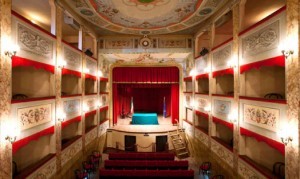
The hamlets San Vito sul Cesano and Montalfoglio
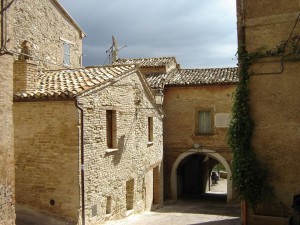
San Vito sul Cesano is a real panoramic terrace. The village is characterized by narrow streets following a fishbone pattern.
Here, visit the Church of S. Apollinare, today known as the church of San Francesco and the Pieve Vecchia, a very ancient church dating back to the XI century and declared a national monument.
Montalfoglio is a medieval village surrounded by ancient walls with typical stone houses. An arch gate leads to the village and above it stands an old tower and a clock. The view from here is really lovely!
Typical Dishes
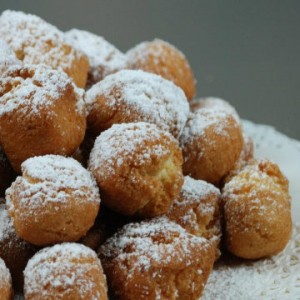 San Lorenzo in Campo has been awarded the Green Flag of Agriculture. Its typical products are spelt, Suasa onions, the sweet Castagnolo and the famous Vernaccia wine. Honey and olive oil are also produced in these areas and regularly receive national awards. Local cuisine is strongly linked to farm traditions. As a first course, I suggest you to try patacchelle, squares of handmade pasta based on wheat and corn flour mixed with water; tagliatelle and pappardelle served with duck, goose or rabbit sauce. Main courses are characterized by roasts made in the oven or grilled, such as pork, lamb, rabbit or game, all flavored with pillotto, a kind of grease or melted lard, dripping on the meat while cooking. Bread and crescia (bread studded with cheese) are accompanied by local cured meats and cheeses, while side dishes include potatoes or mixed vegetables baked in the oven or steamed. Among the traditional sweets, there's the popular spelt Castagnolo which has been given a local designation of origin; Maritozzi (sweet bread studded with raisins); Cicerchiata made with little fried balls and Sciughetti, a dessert with grape must and maize flour. What about wines? Most renowend white wines are Verdicchio and Bianchello; local red wines include the famous Sangiovese. As for digestif, passito and sour cherry wines, such as Vernaccia and Schioppetto.
San Lorenzo in Campo has been awarded the Green Flag of Agriculture. Its typical products are spelt, Suasa onions, the sweet Castagnolo and the famous Vernaccia wine. Honey and olive oil are also produced in these areas and regularly receive national awards. Local cuisine is strongly linked to farm traditions. As a first course, I suggest you to try patacchelle, squares of handmade pasta based on wheat and corn flour mixed with water; tagliatelle and pappardelle served with duck, goose or rabbit sauce. Main courses are characterized by roasts made in the oven or grilled, such as pork, lamb, rabbit or game, all flavored with pillotto, a kind of grease or melted lard, dripping on the meat while cooking. Bread and crescia (bread studded with cheese) are accompanied by local cured meats and cheeses, while side dishes include potatoes or mixed vegetables baked in the oven or steamed. Among the traditional sweets, there's the popular spelt Castagnolo which has been given a local designation of origin; Maritozzi (sweet bread studded with raisins); Cicerchiata made with little fried balls and Sciughetti, a dessert with grape must and maize flour. What about wines? Most renowend white wines are Verdicchio and Bianchello; local red wines include the famous Sangiovese. As for digestif, passito and sour cherry wines, such as Vernaccia and Schioppetto.
Events
During the summer, there're lots of events, many of them dedicated to local products, food & drinks. One of the most famous event is the Castagnolo Festival during Easter time. By the end of June there's the culinary event Grigliato e Mangiato (literally grilled and eaten), dedicated to grilled meat as its name suggests. There's live music and entertainment for kids! Sports lovers cannot miss the great challenge Torneo di Rioni in July, whereas the month of August is very rich in events such as the International Lyric Prize Mario Tiberini, followed by the food festival Crescia co le Foje, all the way to the most anticipated event Pizza in Piazza.
